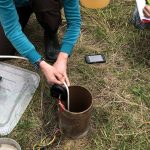Lake Appreciation Month reflections
This year, the Province of BC joined Ontario and 11 U.S. states in proclaiming July as Lakes Appreciation Month to recognize the importance of protecting the health of lakes.
According to the World Atlas website, BC has over 20,000 lakes stretching over 750,000 kilometres. British Columbia’s lakes provide drinking water, habitat for wildlife, energy, recreation, scenic beauty and essential connections to the natural world.
“We are very pleased that the Provincial government acknowledged the need to honour our lakes by making a provincial declaration to this effect,” said Living Lakes Canada Executive Director Kat Hartwig. “Living Lakes Canada has supported the Province and co-authored the report on community-based water monitoring for lakes in BC.”
Climate change is having a variety of impacts on lakes, from temperature increases to subsequent increased rates of harmful cyanobacteria blooms in eutrophic waters. To assist with the monitoring of these irreplaceable natural lake ecosystems, Living Lakes Canada co-authored the 2018 report, An Integrated Lake Monitoring Framework for British Columbia, with the BC Lake Stewardship Society (BCLSS) in response to a request by the BC Ministry of Environment & Climate Change Strategy. This report formed the terms of reference for the development of an integrated framework incorporating the existing BCLSS volunteer monitoring framework, known as the BC Lake Stewardship and Monitoring Program (BCLSMP), with the Province’s BC Lake Monitoring Network (BCLMN).
The report can be viewed here: http://livinglakescanada.ca/wp-content/uploads/2020/07/ilmf-final-report.pdf
“It is essential that we all work to support the health of our lakes in our respective communities. Excellent government declarations such as this are important but what’s most critical are sound policies that support lake health to be implemented by decision makers,” said Hartwig. “We are also working with Fisheries and Oceans Canada to update the federal protocols for Sensitive Habitat Inventory Mapping on lake foreshores to determine where the most sensitive lake foreshore habitat is in order to provide decision makers with tools that included both Traditional Indigenous Knowledge and Western science to inform lake management plans to be incorporated into Official Community Plans for zoning guidelines. Issues such as illegal docks, buoys and retaining walls, along with unrestrained recreation and nutrient loading, all have negative health impacts on lakes ecosystems, which are already under accelerated pressure from climate impacts.”
Photo caption: Moose feeding in Fish Lake, West Kootenays, BC by LLC Communications Manager Nicole Trigg





